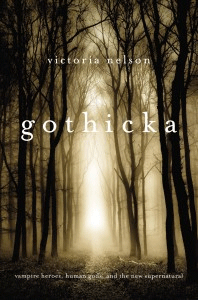By Katie Mooney
Vampires, witches, werewolves, and zombies, once considered the epitome of danger and darkness, are now more prevalent than ever in American pop culture. In her newest book, Gothicka: Vampire Heroes, Human Gods, and the New Supernatural (Harvard University Press, 2012), essayist and fiction writer Victoria Nelson explores the rise of the supernatural in mainstream media.
Gothicka won the 2012 Association of American Publishers PROSE Award for excellence in literature. The award has been given annually since 1976 in recognition of outstanding professional and scholarly works. Previously Nelson published The Secret Life of Puppets, a study of the supernatural grotesque in Western culture which won the 2001 Modern Language Association’s Scaglione Prize for Comparative Literary Studies. Nelson teaches in the Goddard College graduate program in creative writing and is a Phi Beta Kappa member from the University of California, Berkeley, where she was inducted in1965.
According to Nelson, the broadened popularity of the supernatural has grown from centuries of Gothic tradition in more isolated, counterculture settings. In an interview with City Lights Bookstore and Publishing, she traces the historical roots of Gothic literature to mid-eighteenth century England where the Protestant Reformation and Scientific Revolution had together encouraged a culture without mystical fantasy and medieval darkness. The reformation, Nelson states, related anything uncanny to the Devil’s work, while the Scientific Revolution focused on cause and effect within the material world. In this climate, miracles or other supernatural interventions were deemed foolish and impossible by mainstream Euro-American society. In 1764, Horace Walpole wrote Castle of Otranto, considered by many to be the first Gothic novel and a strong reaction to the new rational culture.
Walpole’s work sparked a tremendous outpouring of Gothic writing, solidifying a genre that would remain popular through the eighteenth and into the nineteenth centuries. Nelson writes that early Gothic themes were very distinct—most novels included elements of family turmoil, violence, incest, and death. Over the next 250 years, these themes were carried through in the creation of Victorian ghost stories, pulp horror fiction, and 20th century B movies. Subgenres devoted solely to particular types of characters (witches, warlocks, vampires, werewolves, and zombies) eventually emerged, bringing with them a storm of TV shows, movies, and video games.
Yet Nelson maintains that today’s Gothic resurgence is fundamentally different from preceding eras. Instead of painting the supernatural as an evil dimension separate from human life, monsters, devils, and villains have been revived as heroes, angels, and saviors capable of living among us. According to Nelson, evidence of this trend has been most obvious in the past decade, although changes have been made progressively by writers over time. Author Ann Rice was the first to shift the role of the vampire from antagonist to protagonist in her 1976 novel, Interview with the Vampire. Rice also gave the vampire a first person voice and added the human dimension of ancestors and a vampire family lineage. In the late 20th century, Canadian fantasy writer Tanya Huff developed the idea of the “vampire lover” and portrayed werewolves as primal, hot-blooded, passionate creatures.
Stephanie Meyer’s Twilight series (2005-2008) heightened the commitment of the human/supernatural relationship with the romance of Edward, a vampire, and Bella, a human. Edward comes from a clan of what Nelson calls “ethical feeders” who refrain from drinking human blood. While he desires an intimate relationship with Bella, he is afraid that he may hurt her if they become too close. Eventually, Bella wishes to have the same powers as Edward and transforms into a vampire as well. A more integrated example of vampire life is seen in the television drama True Blood (2008-present), based on The Southern Vampire Mysteries series of novels. The show portrays vampires as a minority group within society campaigning for citizenship and equal rights.
Just what will this brighter, more widespread Gothic revival bring in the future? In an interview with Harvard University Press, Nelson suggests that “this sunnier framework has allowed [Gothic] stories to start working as scripture, as a basis for spiritual practice.” She goes on to explain that imagining alternative worlds and creating new human-friendly mythologies may paradoxically inspire more sophisticated spiritual considerations in mainstream secular culture.
Katie Mooney is a 2012 Phi Beta Kappa graduate of the University of Notre Dame where she majored in psychology and pre-medical studies. Notre Dame is home to the Epsilon of Indiana chapter of Phi Beta Kappa.




